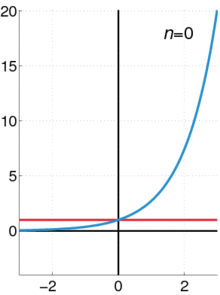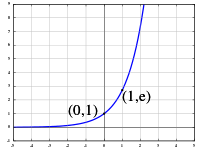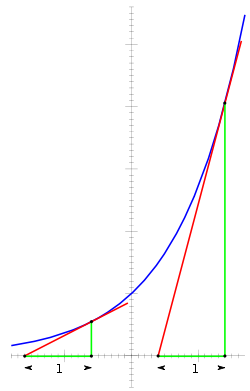The natural exponential function y = ex
In mathematics, an exponential function is a function of the form
in which the input variable x occurs as an exponent. A function of the form
 , where
, where  is a constant, is also considered an exponential function and can be rewritten as
is a constant, is also considered an exponential function and can be rewritten as  , with
, with  .
.As functions of a real variable, exponential functions are uniquely characterized by the fact that the growth rate of such a function (i.e., its derivative) is directly proportional to the value of the function. The constant of proportionality of this relationship is the natural logarithm of the base
 :
:The constant e ≈ 2.71828... is the unique base for which the constant of proportionality is 1, so that the function's derivative is itself:
Since changing the base of the exponential function merely results in the appearance of an additional constant factor, it is computationally convenient to reduce the study of exponential functions in mathematical analysis to the study of this particular function, conventionally called the "natural exponential function",[1][2] or simply, "the exponential function" and denoted by
While both notations are common, the former notation is generally used for simpler exponents, while the latter tends to be used when the exponent is a complicated expression.
The exponential function satisfies the fundamental multiplicative identity
(In fact, this identity extends to complex-valued exponents.) It can be shown that every continuous, nonzero solution of the functional equation
 is an exponential function,
is an exponential function,  , with
, with  . The fundamental multiplicative identity, along with the definition of the number e as e1, shows that
. The fundamental multiplicative identity, along with the definition of the number e as e1, shows that  for positive integers n and relates the exponential function to the elementary notion of exponentiation.
for positive integers n and relates the exponential function to the elementary notion of exponentiation.The argument of the exponential function can be any real or complex number or even an entirely different kind of mathematical object (e.g., a matrix).
Its ubiquitous occurrence in pure and applied mathematics has led mathematician W. Rudin to opine that the exponential function is "the most important function in mathematics".[3] In applied settings, exponential functions model a relationship in which a constant change in the independent variable gives the same proportional change (i.e. percentage increase or decrease) in the dependent variable. This occurs widely in the natural and social sciences; thus, the exponential function also appears in a variety of contexts within physics, chemistry, engineering, mathematical biology, and economics.
| Representation | ex |
|---|---|
| Inverse | ln x |
| Derivative | ex |
| Indefinite integral | ex + C |
The graph of
 is upward-sloping, and increases faster as
is upward-sloping, and increases faster as  increases. The graph always lies above the
increases. The graph always lies above the  -axis but can get arbitrarily close to it for negative
-axis but can get arbitrarily close to it for negative  ; thus, the
; thus, the  -axis is a horizontal asymptote. The slope of the tangent to the graph at each point is equal to its
-axis is a horizontal asymptote. The slope of the tangent to the graph at each point is equal to its  -coordinate at that point, as implied by its derivative function (see above). Its inverse function is the natural logarithm, denoted
-coordinate at that point, as implied by its derivative function (see above). Its inverse function is the natural logarithm, denoted  ,[4]
,[4]  ,[5] or
,[5] or  ; because of this, some old texts[6] refer to the exponential function as the antilogarithm.
; because of this, some old texts[6] refer to the exponential function as the antilogarithm.Formal definition

The exponential function (in blue), and the sum of the first n + 1 terms of its power series (in red).
The real exponential function
 can be characterized in a variety of equivalent ways. Most commonly, it is defined by the following power series:[3]
can be characterized in a variety of equivalent ways. Most commonly, it is defined by the following power series:[3] (see below for the extension of exp x the complex plane). The constant e can then be defined as
(see below for the extension of exp x the complex plane). The constant e can then be defined as  .
.The term-by-term differentiation of this power series reveals that
 for all real x, leading to another common characterization of exp x as the unique solution of the differential equation
for all real x, leading to another common characterization of exp x as the unique solution of the differential equation .
.Based on this characterization, the chain rule shows that its inverse function, the natural logarithm, satisfies
 for
for  , or
, or  . This relationship leads to a less common definition of the real exponential function exp x as the solution y to the equation
. This relationship leads to a less common definition of the real exponential function exp x as the solution y to the equation.
.
Overview
The red curve is the exponential function. The black horizontal lines show where it crosses the green vertical lines.
The exponential function arises whenever a quantity grows or decays at a rate proportional to its current value. One such situation is continuously compounded interest, and in fact it was this observation that led Jacob Bernoulli in 1683[8] to the number
If a principal amount of 1 earns interest at an annual rate of x compounded monthly, then the interest earned each month is x/12 times the current value, so each month the total value is multiplied by (1 + x/12), and the value at the end of the year is (1 + x/12)12. If instead interest is compounded daily, this becomes (1 + x/365)365. Letting the number of time intervals per year grow without bound leads to the limit definition of the exponential function,
From any of these definitions it can be shown that the exponential function obeys the basic exponentiation identity,
The derivative (rate of change) of the exponential function is the exponential function itself. More generally, a function with a rate of change proportional to the function itself (rather than equal to it) is expressible in terms of the exponential function. This function property leads to exponential growth or exponential decay.
The exponential function extends to an entire function on the complex plane. Euler's formula relates its values at purely imaginary arguments to trigonometric functions. The exponential function also has analogues for which the argument is a matrix, or even an element of a Banach algebra or a Lie algebra.
Derivatives and differential equations
The derivative of the exponential function is equal to the value of the function. From any point P on the curve (blue), let a tangent line (red), and a vertical line (green) with height h be drawn, forming a right triangle with a base b on the x-axis. Since the slope of the red tangent line (the derivative) at P
is equal to the ratio of the triangle's height to the triangle's base
(rise over run), and the derivative is equal to the value of the
function, h must be equal to the ratio of h to b. Therefore, the base b must always be 1.
The importance of the exponential function in mathematics and the sciences stems mainly from its definition as the unique function which is equal to its derivative and is equal to 1 when x = 0. That is,
- The slope of the graph at any point is the height of the function at that point.
- The rate of increase of the function at x is equal to the value of the function at x.
- The function solves the differential equation y′ = y.
- exp is a fixed point of derivative as a functional.
Furthermore, for any differentiable function f(x), we find, by the chain rule:
Continued fractions for ex
A continued fraction for ex can be obtained via an identity of Euler:Complex plane
Exponential function on the complex plane. The transition from dark to
light colors shows that the magnitude of the exponential function is
increasing to the right. The periodic horizontal bands indicate that the
exponential function is periodic in the imaginary part of its argument.
As in the real case, the exponential function can be defined on the complex plane in several equivalent forms. The most common definition of the complex exponential function parallels the power series definition for real arguments, where the real variable is replaced by a complex one:

Termwise multiplication of two copies of these power series in the Cauchy sense, permitted by Mertens' theorem, shows that the defining multiplicative property of exponential functions continues to hold for all complex arguments:
 for all
for all 
The definition of the complex exponential function in turn leads to the appropriate definitions extending the trigonometric functions to complex arguments.
In particular, when
 (
( real), the series definition yields the expansion
real), the series definition yields the expansion
In this expansion, the rearrangement of the terms into real and imaginary parts is justified by the absolute convergence of the series. The real and imaginary parts of the above expression in fact correspond to the series expansions of
 and
and  , respectively.
, respectively.This correspondence provides motivation for defining cosine and sine for all complex arguments in terms of
 and the equivalent power series:[10]
and the equivalent power series:[10]![{\displaystyle \cos z:={\frac {1}{2}}{\Big [}\exp(iz)+\exp(-iz){\Big ]}=\sum _{k=0}^{\infty }(-1)^{k}{\frac {z^{2k}}{(2k)!}}}](https://wikimedia.org/api/rest_v1/media/math/render/svg/2491ca0062d85fde7dd6ce08ae1ae1828bc411f6) and
and![{\displaystyle \sin z:={\frac {1}{2i}}{\Big [}\exp(iz)-\exp(-iz){\Big ]}=\sum _{k=0}^{\infty }(-1)^{k}{\frac {z^{2k+1}}{(2k+1)!}}}](https://wikimedia.org/api/rest_v1/media/math/render/svg/d5c5ed2b67156ed6e25772e9de18f4a3bf820ba6) for all
for all 
The functions exp, cos, and sin so defined have infinite radii of convergence by the ratio test and are therefore entire functions (i.e., holomorphic on
 ). The range of the exponential function is
). The range of the exponential function is  , while the ranges of the complex sine and cosine functions are both
, while the ranges of the complex sine and cosine functions are both  in its entirety, in accord with Picard's theorem, which asserts that the range of a nonconstant entire function is either all of
in its entirety, in accord with Picard's theorem, which asserts that the range of a nonconstant entire function is either all of  , or
, or  excluding one lacunary value.
excluding one lacunary value.These definitions for the exponential and trigonometric functions lead trivially to Euler's formula:
 for all
for all 
We could alternatively define the complex exponential function based on this relationship. If
 , where
, where  and
and  are both real, then we could define its exponential as
are both real, then we could define its exponential as
where exp, cos, and sin on the right-hand side of the definition sign are to be interpreted as functions of a real variable, previously defined by other means.[11]
For
 , the relationship
, the relationship  holds, so that
holds, so that  for real
for real  and
and  maps the real line (mod
maps the real line (mod  ) to the unit circle. Based on the relationship between
) to the unit circle. Based on the relationship between  and the unit circle, it is easy to see that, restricted to real
arguments, the definitions of sine and cosine given above coincide with
their more elementary definitions based on geometric notions.
and the unit circle, it is easy to see that, restricted to real
arguments, the definitions of sine and cosine given above coincide with
their more elementary definitions based on geometric notions.The complex exponential function is periodic with period
 and
and  holds for all
holds for all  .
.When its domain is extended from the real line to the complex plane, the exponential function retains the following properties:
 .
.Extending the natural logarithm to complex arguments yields the complex logarithm log z, which is a multivalued function.
We can then define a more general exponentiation:
- (ez)w ≠ ezw, but rather (ez)w = e(z + 2πin)w multivalued over integers n
- Plots of the exponential function on the complex plane
Computation of ab where both a and b are complex
Complex exponentiation ab can be defined by converting a to polar coordinates and using the identity (eln(a))b= ab:Matrices and Banach algebras
The power series definition of the exponential function makes sense for square matrices (for which the function is called the matrix exponential) and more generally in any Banach algebra B. In this setting, e0 = 1, and ex is invertible with inverse e−x for any x in B. If xy = yx, then ex + y = exey, but this identity can fail for noncommuting x and y.Some alternative definitions lead to the same function. For instance, ex can be defined as
Lie algebras
Given a Lie group G and its associated Lie algebra , the exponential map is a map
, the exponential map is a map  ↦ G satisfying similar properties. In fact, since R
is the Lie algebra of the Lie group of all positive real numbers under
multiplication, the ordinary exponential function for real arguments is a
special case of the Lie algebra situation. Similarly, since the Lie
group GL(n,R) of invertible n × n matrices has as Lie algebra M(n,R), the space of all n × n matrices, the exponential function for square matrices is a special case of the Lie algebra exponential map.
↦ G satisfying similar properties. In fact, since R
is the Lie algebra of the Lie group of all positive real numbers under
multiplication, the ordinary exponential function for real arguments is a
special case of the Lie algebra situation. Similarly, since the Lie
group GL(n,R) of invertible n × n matrices has as Lie algebra M(n,R), the space of all n × n matrices, the exponential function for square matrices is a special case of the Lie algebra exponential map.The identity exp(x + y) = exp(x)exp(y) can fail for Lie algebra elements x and y that do not commute; the Baker–Campbell–Hausdorff formula supplies the necessary correction terms.
Transcendency
The function ez is not in C(z) (i.e., is not the quotient of two polynomials with complex coefficients).For n distinct complex numbers {a1, …, an}, the set {ea1z, …, eanz} is linearly independent over C(z).
The function ez is transcendental over C(z).
Computation
There are several algorithms for computing the exponential function.[which?] When the argument has a small absolute value, the result is near from one, and computing the difference may produce a loss of accuracy.
may produce a loss of accuracy.Following a proposal by William Kahan, it may thus be useful to have a dedicated program, often called
expm1, for computing ex−1 directly, without passing by the computation of the exponential. For example, if the exponential is computed by using its Taylor series
A similar approach has been used for the logarithm (see lnp1).[nb 1]
An identity in terms of the hyperbolic tangent,





































